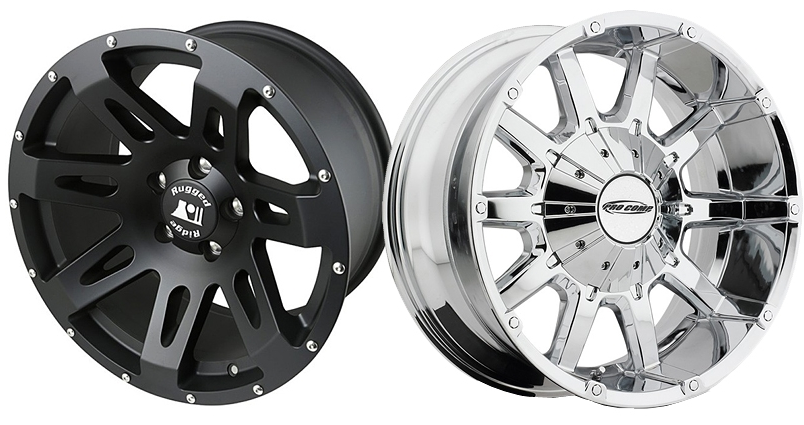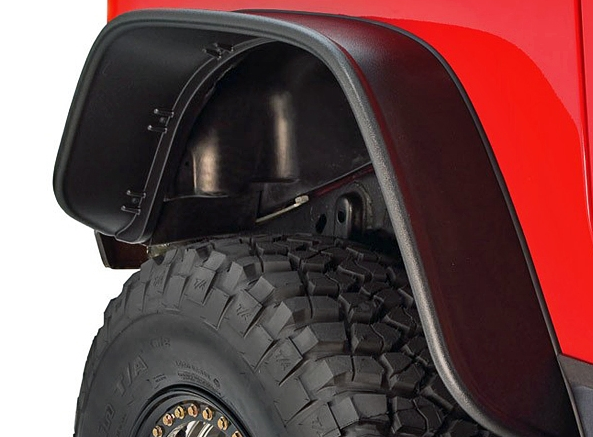


How Big Can My Jeep Tires Be Without a Lift Kit?
What's the biggest Jeep tire I can have without a lift kit?
Since larger tires are a big part of owning a Jeep, especially if you want to to go off road at any time, it's a common question we hear around here. And truly, there is no cut and dry answer, but we can look at some of the parameters, and get close to what you need.
For the most part, we're going to use a Wrangler as our main focus, but the information covered can apply to virtually any 4x4 vehicle.
Stock Rims Play a Role in Your Tire Upgrade Options
When trying to outfit your vehicle with the biggest Jeep tire you can think of, the first thing to consider is whether you will be running a stock size rim, which are usually the ones that came on your Wrangler from the factory. These might range in size from 15 inches to maybe 18 inches, depending on the Jeep model you have and the options selected when it was purchased.
You want to think about the overall height of the tire and the rim together. The idea is to get a tire/wheel combo that gives you more height, but doesn't interfere with the fenders, or prevents your suspension from articulating to it's full travel. Meaning, you want to make sure you can still get the maximum flex the stock suspension will allow.
It's also a good thing to make sure your suspension is up to spec. If you have a Jeep with high mileage, and the suspension is weak anywhere, you might get too much sloppy movement, causing the tires to rub somewhere. Typically it's a spring issue you're worried about, since those determine the height of the vehicle. If you're unsure, ride height is one of the measurements that are taken when getting an alignment, so if even one corner is too low (below stock ride height specs, because of a weak spring or other issue), it will be found there.
If the vehicle sits level (all four corners should have the correct height to use as a baseline), and the suspension parts are in good working order, that's a good start. You don't want three tires that clear everything, and one corner tire giving you rubbing issues.
On a JK Wrangler model for instance, many Jeep owners have said they can fit up to a 33" tire, but that's just a matter of getting the tire/rim bolted on. Fender rubbing and other issues will probably come up. If you drive your Wrangler on city smooth streets, with little or no suspension flex, that's one thing. Taking your Jeep out to the trails on a bone stock height suspension with a 33" tire is another matter entirely.
Another important thing to take into consideration is the width of the tire. On a 33" tire, that can range from slightly less than 10 inches to over 11 inches as a general rule. You might be able to get by with the 33" tire in terms of height, but the width will probably cause rubbing from inner fenders, suspension parts, or end links. Especially if your Wrangler is still stock height.
There's a big difference between saying a tire will fit, and actually using that tire on a day to day basis.
Factory Rim Backspacing Limitations
Even if you were to go down from a 33" tire to a 32" or 30" tire, the width (and insufficient backspacing) might still cause issues.
Something to take into consideration is backspacing. You're limited by the factory backspacing of a stock rim. With an aftermarket rim, you get many more choices, which gives you an opportunity to move the tire outward, away from the vehicle. You can still have issues on a stock height vehicle though. Eventually, depending on the size of the tire you're trying to run, you'll have to get some kind of lift to clear a larger than stock tire. We have a lot more info on backspacing in this article. We recommend that you check it out before buying a tire or a new rim, as it can be very helpful.
Fender Flares Can Indicate if a Tire is Too Large
Normally when running a larger tire, the first place the tire rubs would be a fender flare. If that's the case, you can trim the flare, or replace it with the many types of aftermarket fender flares that are specifically designed to give you more clearance for a larger tire.
The front flare is usually a little more friendly than the rear flare for this mod. On the rear, you might rub against the body or fender wheel well, and that's much more complicated to work around.
Opt for a Body Lift Instead of a Suspension Kit
Later, if you change your mind, you can always upgrade to a Jeep body lift kit, which is less expensive and easier to install than a full blown suspension kit. The body lift will also give you just a couple of more inches of height for extra tire clearance.

The thing to remember is that every vehicle is a little different, so there is no exact answer. There are just too many variations. But with this information on hand, it may help you to prepare for what to expect, and get you closer to getting the largest tire you can safely use without a lift kit or suspension upgrade.

